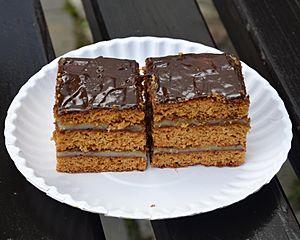Miodownik (cake) facts for kids

Chonek łejkech in Sanok
|
|
| Alternative names | Chonek łejkech |
|---|---|
| Type | Cake |
| Course | Dessert |
| Place of origin | Galicia, Central Poland |
| Serving temperature | Cold |
| Main ingredients | Honey |
Miodownik (say: mee-oh-DOV-neek), also known as chonek łejkech (say: HO-nek WEY-kek), is a yummy dessert cake. Its name comes from the German word Honig, which means honey. This cake is often a special treat at weddings, especially in Jewish cuisine. Jewish cuisine includes traditional foods prepared by Jewish people around the world.
What is Miodownik?
Miodownik is a sweet cake that tastes a lot like honey. It's a type of dessert, which means it's usually eaten after a main meal. It's often served cold, making it a refreshing treat. This cake is very popular in parts of Eastern Europe, especially in Poland.
How is Miodownik Made?
Making miodownik is a bit like making a sponge cake. First, the dough is prepared. Then, a special honey topping is made. This topping uses honey that is melted and then cooled down. Other sweet ingredients, like sugar, are also added to the honey mix.
Once the dough is ready, it's poured onto a baking sheet. Then, it's baked in an oven at about 200°C (that's about 390°F). The cake usually bakes for around 40 minutes until it's golden brown and cooked through.
Where Does Miodownik Come From?
The recipe for miodownik has a long history. It first came from a region called Galicia. This area is now part of Poland and Ukraine. It also became very popular in Central Poland. Over time, this delicious honey cake became a beloved part of special celebrations in these regions.

